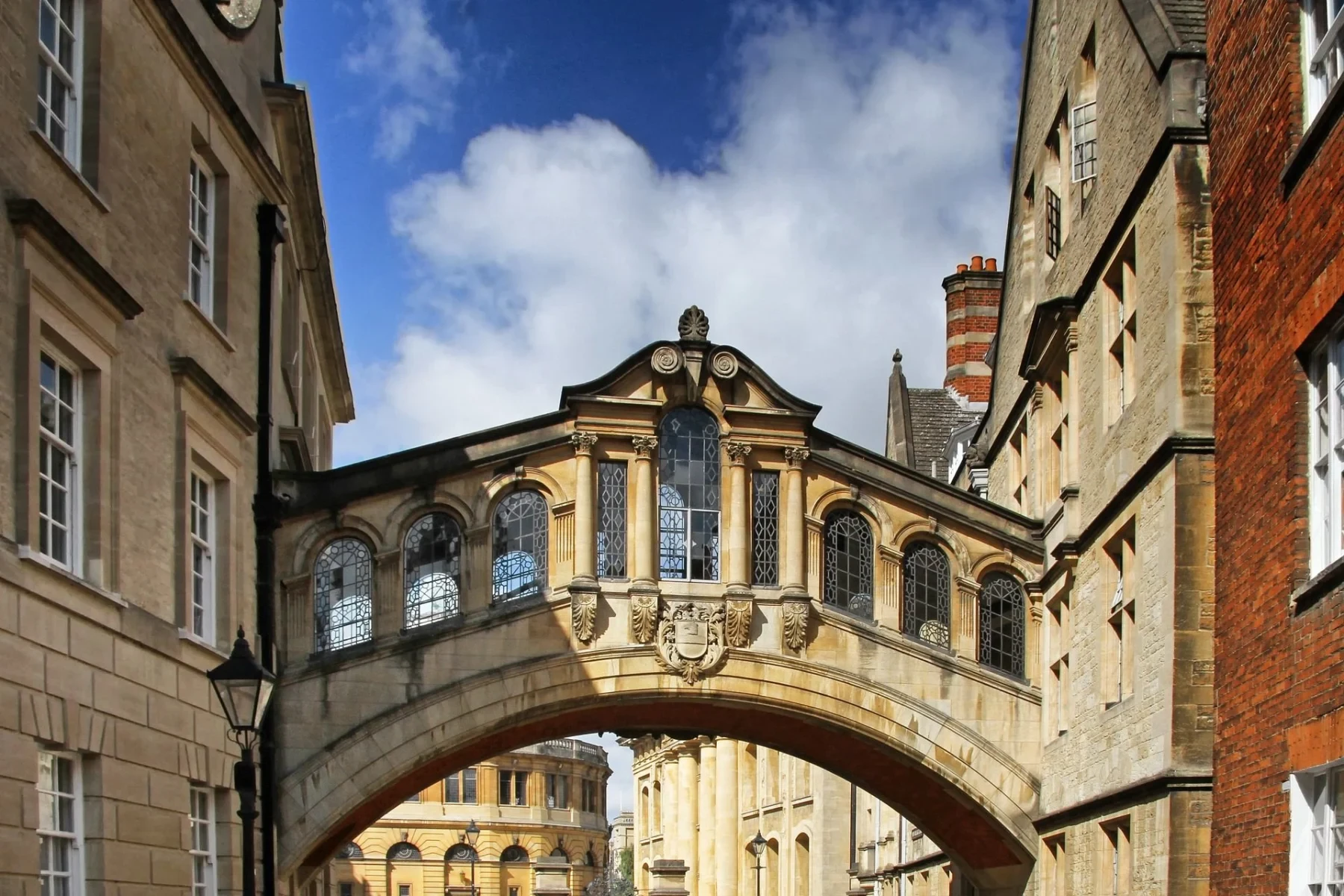
A Brief History of the Bridge of Sighs
In the second blog post of our Oxford history series, we take a brief look at the history of Oxford's notorious Bridge of Sighs.
Sitting opposite the entrance to the Bodleian Library, the Hertford Bridge – more commonly known as the Bridge of Sighs – is a covered skyway which connects the two sections of the college over New College Lane in Oxford.
Known for its intriguing design, it has become famous for tourists over the past century, all eager to capture its impressive architecture and centralised coat of arms.
But how did it come to exist? We take a look at the history of Hertford College and the bridge’s establishment.
What’s Included in an Oxford Summer Course?
Our tailored summer courses for ages 9-24 include all teaching and academic content, accommodation, meals (including Friday night formal dinners), a prize-giving ceremony, all-day trips and activities, airport transfers, access to Oxford Summer Courses Foundations, travel and medical insurance, and a welcome pack. Apply now to secure your spot in one of our comprehensive summer courses.
Firstly, a few facts…
-
Despite being nicknamed after its similarity to the Bridge of Sighs in Venice, Hertford Bridge was never intended to be a replica. Instead, it seems to bear a closer resemblance to the Rialto Bridge in the same city.
-
There is an ancient tale of Hertford College which states that many years ago, there was a survey of the health of Oxford University students. According to the survey, when Hertford College’s students were found to be at their heaviest weight, the college would close off the bridge in order to force the students to take the stairs. However, this story was actually false. The bridge is always open, and requires students to use more stairs than if they didn’t use the bridge at all.
-
Although similar in design, the Bridge of Sighs in Cambridge was built first in 1831, almost 100 years before Hertford Bridge in Oxford.
-
The bridge has regularly featured on the big and small screens, making an appearance in X Men: First Class and is shown frequently on Inspector Morse.
<u>The Early Years</u>
1282: Hertford College – of which the Bridge of Sighs is part of – first evolved. Known as Hart Hall, it was founded by Elias de Hertford and stood on the site where some of the oldest parts of the current college are situated today.
1740: After securing a charter and statutes, Principal Newton fully established Hertford College after incorporating Hart Hall as a full college of the University of Oxford.
<u>The 19th Century</u>
1805: Sadly, after an overly ambitious conception and lack of funding, Hertford College was dissolved. Part of the remaining assets were transferred to the University of Oxford to create the Hertford Scholarship and the last remaining fellow, Vice-Principal Hewitt, retained his fellowship until it expired in 1818, marking the end of Hertford College.
1816: After the first Hertford College collapsed, it opened up a new opportunity for another institution to expand. This institution was Magdalen Hall, which had begun as a hall of residence associated with the grammar school attached to Magdalen College (founded in 1480).
1822: Due to its academic identity, an Act of Parliament in 1816 allowed Magdalen College to acquire the former site of Hertford College. Led by Principal Macbridge, in 1822, Magdalen Hall took possession of the Hertford College site upon the complete build of two new wings fronting Catte Street.
1874: Principal Michel successfully granted Magdalen Hall to collegiate status when he received a benefaction from MP, Thomas Baring. An Act of Parliament refounded Hertford College, comprising of the Principal and Fellows of Magdalen Hall, and a number of fellows chosen by Baring.
Under Principal Boyd (1877-1922), the new college became fully established and had its site expanded to include a new Lodge and Hall, the New Quad, a chapel and several other buildings. Designed by architect Thomas Graham Jackson, he was also commissioned to design the Hertford Bridge which would be used to connect two parts of the college spanning New College Lane.
1913: The construction of the Bridge of Sighs was completed and was open for use in January 1914.
<u>The 21st Century</u>
In 2013, Hertford Bridge celebrated its centenary. To mark the occasion, the university installed a unique sound composition which was recorded by students and members of staff.
Today, students still use the bridge daily as a walkway from the old to the new quadrangles of Hertford College. The building to the north consists mainly of student accommodation, whereas the southern structure houses administrative offices.
What is the origin of the nickname "Bridge of Sighs" for Hertford Bridge, and how does it differ from the Bridge of Sighs in Venice?
The nickname "Bridge of Sighs" for Hertford Bridge originated due to its visual resemblance to the Bridge of Sighs in Venice. However, unlike the Bridge of Sighs in Venice, Hertford Bridge was never intended to be a replica. Instead, it bears a closer resemblance to the Rialto Bridge in Venice.
What led to the establishment of Hertford College, and what significant events in the 19th century shaped its history?
Hertford College, originally known as Hart Hall, first evolved in 1282, founded by Elias de Hertford. In the 19th century, after an ambitious conception and lack of funding, Hertford College was dissolved in 1805. This collapse created an opportunity for Magdalen Hall to expand, acquiring the former site of Hertford College in 1822. Hertford College was re-founded in 1874 under the leadership of Principal Boyd, and its expansion included the construction of the Hertford Bridge (Bridge of Sighs) in 1913.
How did the Bridge of Sighs become a part of Hertford College, and what event marked its completion in the early 20th century?
In 1874, under Principal Boyd's leadership, Hertford College was re-founded, and architect Thomas Graham Jackson was commissioned to design the Hertford Bridge (Bridge of Sighs). The construction of the Bridge of Sighs was completed in 1913, and it opened for use in January 1914. The bridge served as a connection between two parts of Hertford College, spanning New College Lane.
Ready to Join Oxford Summer Courses?
After submitting your application, we'll be in touch very soon to inform you of the outcome. Apply now to begin your journey with Oxford Summer Courses!
Share this article
Summary
Discover Oxford's Hertford Bridge, known as the Bridge of Sighs. Built in 1913, it connects Hertford College and features impressive architecture. Learn its history and its role in movies. Share your thoughts on this iconic bridge.
